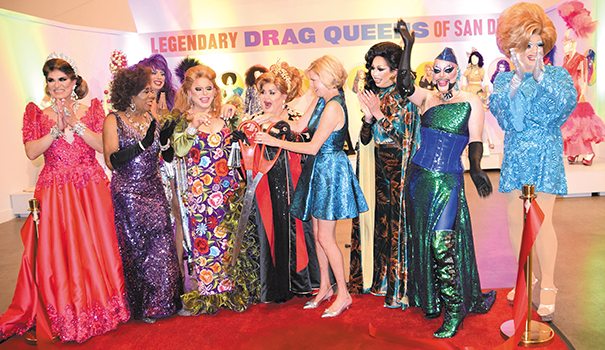By Albert H. Fulcher | Editor
In conjunction with the current exhibition, “LGBTQ+ San Diego: Stories of Struggles and Triumphs,” the San Diego History Center honored the performance art of drag in San Diego on June 21 at the San Diego History Center. Running through Sept. 8, the “Legendary Drag Queens of San Diego” commemorates the 50th anniversary of the Stonewall uprising.
Curated by internationally-known scholar Dr. Lillian Faderman, in collaboration with the Imperial Court de San Diego, the exhibition displays fabulous costumes, jewelry, and other personal belongings provided by nine leading “drag queens” who made their name locally and nationally. Honorary chair of the exhibit is San Diego’s first lady Katherine Faulconer.
“Long before San Diego native RuPaul became an international star and household name,” said Faderman, “drag queens used sartorial flair and performance skills to raise money for San Diego charities, including AIDS organizations, scholarships for needy youth, Christmas toy drives, and a winter blanket drive for the homeless in San Diego and Tijuana.”
In addition to RuPaul, a native San Diegan, included in the exhibit are: Empress Nicole the Great, Chad Michaels, Tootie, Glitz Glam, Franceska, Paris Sukomi Max, Babette Schwartz, Lala Too and Norma. All were present for the grand opening with the exception of Chad Michaels, who was out on tour.
San Diego History Center CEO and President Bill Lawrence said the exhibition could not be possible without the incredible help from the queens being honored.
“This group is extraordinary, and we are honored to be sharing your stories with San Diego and the visitors to our region,” Lawrence said.
Faderman said that drag queens have a long history of fighting injustice in San Diego and elsewhere. She said the exhibit was appropriate to commemorate the 50th anniversary of the Stonewall rebellion, a beginning of the modern gay rights movement, and that drag queens were certainly important in that rebellion.
“Our exhibit is not about social injustice,” Faderman said. “It’s about drag as entertainment, drag as glamour and imagination, playfulness and great fun. But I have to say, as I wrote the text and got to know all of the diverse stories of these drag queens, what I learned in every case is that they have used their entertaining talents to raise money for many worthwhile causes.”
Latino gay rights activist, San Diego City Human Rights Commissioner, and chair of the International Imperial Courts system, Nicole Murray Ramirez said he believes that this addition to the history center’s LGBTQ+ exhibition is a fitting tribute to commemorate the Stonewall uprising.
Ramirez said among those fighting back at the Stonewall riots were Latino drag queen Sylvia Rivera and African American drag queen Marsha P. Johnson.
“But we must remember that most certainly, they were not alone,” Ramirez said. “As lesbians, gay men, and young queers took lead in these riots, it is important to know that many of these gay, lesbian, bisexual and transgender were people of color, street queens, homeless and many of them were LGBT youth.”
Ramirez said drag queens have played an important historic role in building the LGBT community and the civil rights movement not only in America, but around the world, even before Stonewall.
“Drag shows led the way in raising funds for the fight and campaigning against homophobes like Anita Bryant and (California Representative) John Briggs. Almost every weekend across this great nation, there are drag queen shows being held to this day to raise money for our GLBT charities and organizations. Drag queen shows were nearly the only way of raising money for the GLBT community in the 1960s and ’70s. Today, we are celebrating the important role that drag queens have played in building the San Diego GLBT community.”
Ramirez said drag queen benefits in the ’70s raised most of the money to establish the LGBT Community Center, San Diego Pride, Metropolitan Community Church and many other organizations.
“The important role that drag queens played during the early dark years of AIDS in the 1980s is undeniable,” Ramirez continued. “The first benefit for the AIDS Assistance Fund was a drag show at BJ’s and the seed money for San Diego AIDS Walk was raised by drag shows.”
Learn more at sandiegohistory.org.
— Albert Fulcher can be reached at [email protected].




















